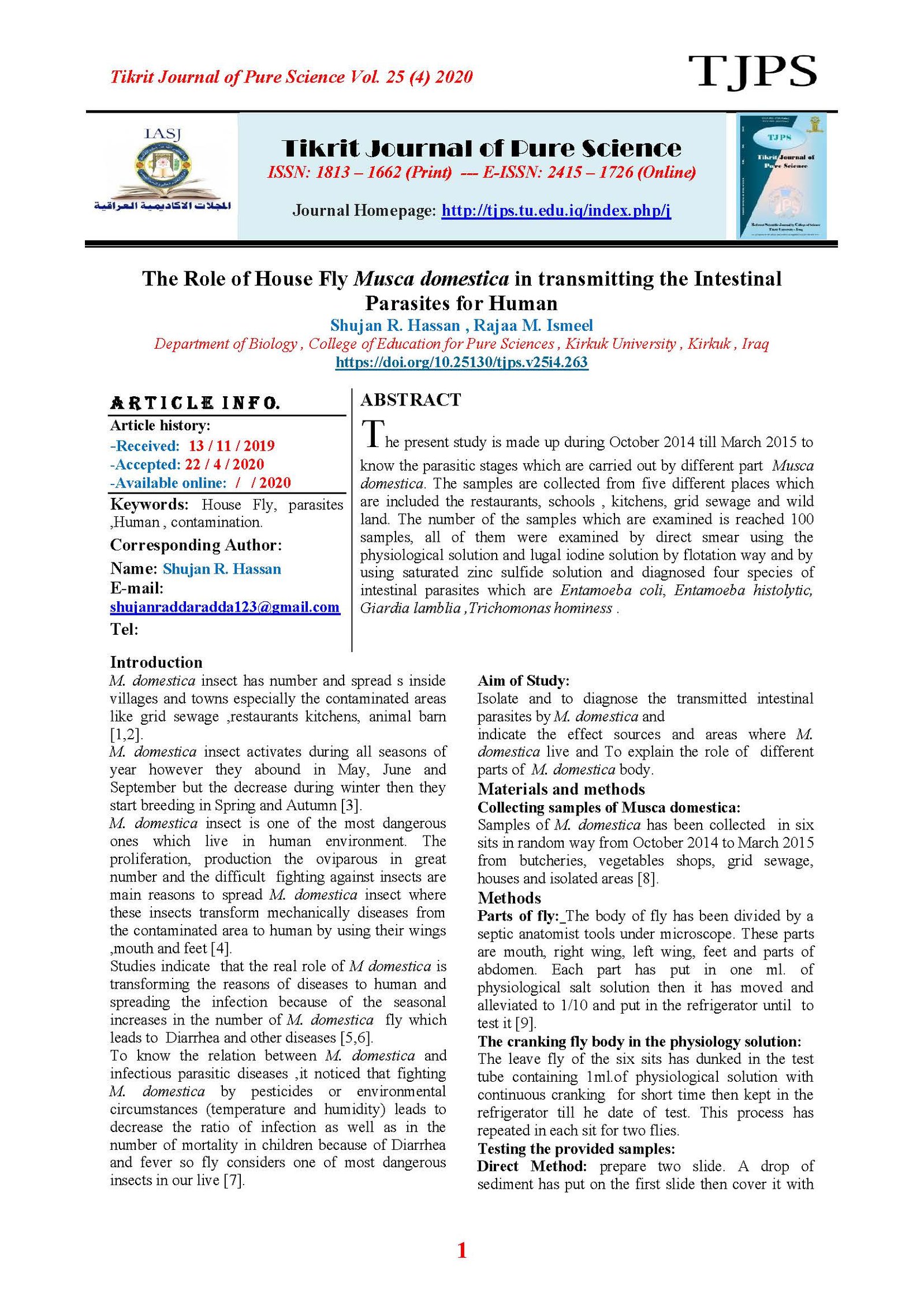The Role of House Fly Musca domestica in transmitting the Intestinal Parasites for Human
Main Article Content
Abstract
The present study is made up during October 2014 till March 2015 to know the parasitic stages which are carried out by different part Musca domestica. The samples are collected from five different places which are included the restaurants, schools , kitchens, grid sewage and wild land. The number of the samples which are examined is reached 100 samples, all of them were examined by direct smear using the physiological solution and lugal iodine solution by flotation way and by using saturated zinc sulfide solution and diagnosed four species of intestinal parasites which are Entamoeba coli, Entamoeba histolytic, Giardia lamblia ,Trichomonas hominess .
Article Details

This work is licensed under a Creative Commons Attribution 4.0 International License.
Tikrit Journal of Pure Science is licensed under the Creative Commons Attribution 4.0 International License, which allows users to copy, create extracts, abstracts, and new works from the article, alter and revise the article, and make commercial use of the article (including reuse and/or resale of the article by commercial entities), provided the user gives appropriate credit (with a link to the formal publication through the relevant DOI), provides a link to the license, indicates if changes were made, and the licensor is not represented as endorsing the use made of the work. The authors hold the copyright for their published work on the Tikrit J. Pure Sci. website, while Tikrit J. Pure Sci. is responsible for appreciate citation of their work, which is released under CC-BY-4.0, enabling the unrestricted use, distribution, and reproduction of an article in any medium, provided that the original work is properly cited.
References
[1] Nylen G.: Dunstan, F.: Palmer. S.R.; Anderson, Y.; Bager, F.; Cowden, J.; Feierl, G.; Gallway, Y.; Kapperud and Runtu, P. (2002). The seasonal distribution of campylobacter infection in nine European countries and new Zealand. Epi infect. 128;383-390.
[2] Broce, A. B. (1993). Dispersal of house flies and stable flies Research bulletin no. 13 Agricultural Research Division, University of Nebraska, Lincoln. 22:971-977.
[3] Brain M; Wiegmann K;YEATES, J and Thorne, H. K (2003). Time flies, a new molecular time scale for brachceran fly evolution without aclock, systimatis biology.,52(6):745-756.
[4] krafsure, E.S;, Black, I.V.; Candbarens, D.A (1985). Age structure and reproductive biology of anatural house fly (dipteral: Muscidae) population Envi. Entomology14:159-164.
[5] Dame, D. and Fasulo, T.R (2003). Flies Public Health Pesticide Applicator training manual. New York. USA.2:9-11.
[6] Watson, D.W., Kaufman. P., A. Rutz. D and S. Glenister. C. (2001). Impact of the lesser meal worm, Alphitobins diaperinus(panzer),on the establishment of the predaceous beetle, cercinops pumilio Erichson, for the control of house fly, musca domestica in caged layer poultry houses biological control.20:8-9
[7] Coker, A.O., Lsokpehi, R,D. and Obi, CI. (2002). Human campylobactriosis in developing countries. Emerg infect Dis.,8:237-244.
[8] Mahmood, I. A (1988). Classification and dividing insects-Ministry of Higher Education and Scientific Research Establishment of Institutes. Second Edition 1:33-34.
[9] Gupte, S, (1984). The short text book of medical microbiology 2nd ed .New York. USA. 30:60-68
[10] Al-Baita S. R (2012). epidemiological Study for the intestinal parasites in Duz city. Tikrit Journal of pure science. 17(3):( 108-115).
[11] W.H.O.(2003).Cited by Global Healhy Council .wet master of Glob Health. Internet in 12:12:2005.
[12] Prescott L.M.; Harly, J. Pan (1996). Microbiology 3rd ed .MCgraw by Lippin cott William and willkins, Philadelphia pp.: Hill companies ,icn ,p,;799-802.
[13] Evan Arthur, T. (2007). Manual og obsteries 7th ed .published 2: 274-275
[14] Hassan, Ayad Hazim (2009). Isolated microscopic and genetic study from pathological conditions in human, Master thesis, college of science/University of Musel.26-28.
[15] Brain M. Wiegmann, David K. Yeast, Jeffery L. Thurne, H Hirohisa Kishino (2003)." teme flies, anew molecular time-scale for brachceran fly avolution without aclock".systimatic biology.,52(6):745-756.
[16] Gilamore, M. (2002). The enterococci: pathogensis molecular biology and antibiotic resistance, ASM Press Washington. D. C. 4(8):181-196.
[17] Bellanger, A.p.; Cabaret, O.; Costa, J.M.; Fuolet, F,; Bretaug, S. and Botterel, F (2008). Twounusnal occurrences of Trichomonaisis vapid species identification by P.C.R., J. of ciln .Mic . Bio .,vol 46,No.9.pp.:359-361.
[18] Parazitol, W (2004). Studies on the suscepility of Trechomones. Hoministo some abiotic factor .I. Preliminary assessment of antitichomanal activity selected compouid in viro, U.S. National Liberary of Medivine , National institutes of Health.1:17-19.
[19] Honda, Y.; Ueki, M.; Okuda G.; Onose, R; Usami, R,; Horkoshi, K. and Osads, H. (2004). Isolation and biological properties of a new cell cycle inhibitor, curvularol, isolated. RK 97.F166, J, Antib., 54:10-16.
[20] Mahmoud, Ashrad Jamal; Tawfiq, Alae Imad; Alham Aied and Khalad, Thabt Muthehar (2018). parasitic infection in Musca domestica which isolated from Tikrit city, Tikrit Journal of pure science ,33(5): 7-12.
[21] Ahmed, M.; Hassan, M. and Zayed, A. (1995). Microbialflora associated with some species of biting and non- bitting flies (Diptera). J. Fac. Edu., 20:477-489.
[22] Jumaa, Ghareeb Mahmood (2008) Abdull Wahab , AlGailani Press-Qairo -3rd edition, p:11-12.
[23] Ahmed, Josef Al-Haaj (2003).The scientific prodigy encyclopedia. Ibn Hajar press-Damascus.3rd edition p,13-17.
[24] Schmidt, G.S. and Roberts, L.S. (2000). Foundation of parasitology 6th edition., Singapore. 28(2):165-174.
[25] Steinhouse, E.A.(1997). Insect microbiology, Heffner publishing camp. New York ,pp.;763-768.
[26] Coke, A.O.; Isokpehi, R. D.; Thomas, B. N.; Amisa, K. O. and Obi, Cl. (2002). Human Campylobacteriosis in developing countries Emerge Infect Dis.; 8: 237- 244.
[27] Watson, D.W; Kanfman. p; Rutz, D. and Glenister, S (2001). Impact of the lesser meal worm,on the establishment of the predaceous beetle, carcinops pumilio Erichson. for the control of house fly, Musca domestica in caged lager poultry houses. Biological control, 20:8-9.
